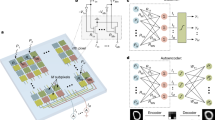Abstract
A VLSI retina is a device that intimately associates an optoelectronic layer with processing facilities on a monolithic circuit. Combining acquisition and processing provides a better balance between between data flows and bandwidths. It is also expected to reveal fruitful shortcuts between microelectronic phenomena and vision-oriented information processing. Yet, except for simplistic environments and applications, analog hardware will not suffice to process and compact the raw image flow from photosensitive arrays. To solve this output problem, an on-chip array of bare boolean processors can be used to provide versatility from programmability. Since the monolithic constraint implies a memory shortage, the abilities of such a retina will be limited to a rough type of vision, but specific algorithmic techniques can cope with it. We have used shift registers with some tricky circuitry to build a minimal retina boolean processor with less than 30 transistors. The successful integration and testing of and experimentation with such a 65×76 retina are presented.
Similar content being viewed by others
References
Bayer BE (1973) An optimum method for two-level rendition of continuous tone pictures. IEEE International Conference on Comunication, pp 2611–2615
Bernard T (1991) From sigma-delta modulation to digital halftoning of images. IEEE Int. Conf. on Acoustics, Speech and Signal Processing, Toronto, pp 2805–2808
Bernard T (1992) Turning blue sound into blue noise. IEEE Int. Conf. on Acoustics, Speech and Signal Processing, San Francisco, III: 197–200
Bernard T, Devos F, Zavidovique B (1991) Réseau bidimensional périodique de mémorisation et de traitement booléen d'images. French licence 91–13703
Bernard T, Garda P, Reichart A, Zavidovique B, Devos F (1988) Design of a halftoning integrated circuit based on analog quadratic minimization by non-linear multistage switched capacitor network. IEEE International Symposium on Circuits and Systems, Helsinki pp 1217–1220
Bernard T, Garda P, Zavidovique, B (1990) A neural halftoning algorithm suiting VLSI implementation. IEEE Int. Conf. on Acoustics, Speech and Signal Processing, Albuquerque, New Mexico, pp 981–984
Devos F, Garda P, Zavidovique B (1985) Rétine intégré à réseau de processeurs. French licence 85–09256
DeWeerth SP, Mead CA (1988) A two-dimensional visual tracking array. Proc MIT Conference on VLSI, MIT Press, Cambridge, Mass., pp 259–275
Eid ES, Fossum ER (1988) CCD focal plane array analog image processor. Proc SPIE Real Time Signal Processing XI, San Diego, Calif. 977:298–306
Floyd RW, Steinberg L (1976) An adaptive algorithm for spatial grey scale. Proc Symposium on Image Display 17:75–77
Fossum ER (1989) Architectures for focal plane image processing. Opt Eng 28:865–871
Garda P (1984) Vers une architecture intégrée de traitement combinatoire local des images. PhD Thesis, University of Paris XI, Orsay, France
Garda P, Reichart A, Rodriguez H, Devos F, Zavidovique B (1988b) Yet another mesh array smart sensor? Proc. Int. Conf. on Pattern Recognition, Rome, pp 863–865
Hershey JE, Liberati R, Hammer DS (1989) New focal plane architecture and transform for fast target recognition. Appl Opt 28:3810–3813
Koch C, Marroquin J, Yuille A (1986) Analog “Neuronal” networks in early vision. Proc National Academy of Science USA 83, pp 4263–4267
Mead CA (1988) Analog VLSI and neural systems. Addison-Wesley
Reichart A (1988) Aspects algorithmiques d'une vision fruste d'un robot embarquable. PhD Thesis, University of Paris XI
Tanner JE (1986) Integrated optical motion detection. PhD Thesis, Department of Computer Science, California Institute of Technology
Ulichney RA (1988) Dithering with blue noise. IEEE Proc 76:56–80
Umminger CB, DeWeerth SP (1989) Implementing gradient following in analog VLSI. Proc of the Decennial Caltech Conference on VLSI, pp 195–208
Zavidovique B (1981) Contribution à la vision des robots. Doctorate of Sciences Thesis, UTC Compiègne, France
Zavidovique B, Bernard T (1990) Smart retinas. Proc. COGNITIVA '90, pp 495–515
Author information
Authors and Affiliations
Corresponding author
Rights and permissions
About this article
Cite this article
Bernard, T.M., Nguyen, P.E., Devos, F.J. et al. A programmable VLSI retina for rough vision. Machine Vis. Apps. 7, 4–11 (1993). https://doi.org/10.1007/BF01212411
Issue Date:
DOI: https://doi.org/10.1007/BF01212411




